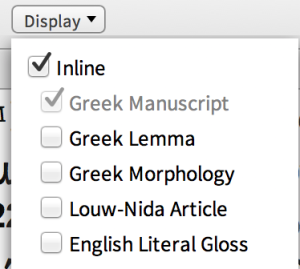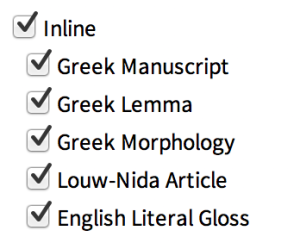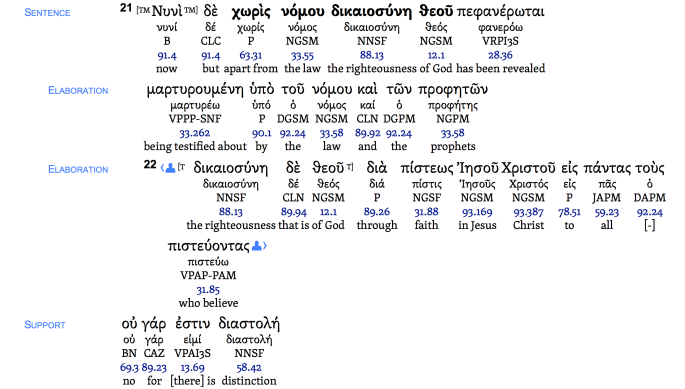As would be expected from anything produced by Steven Runge, this is a most useful tool. It is intended to help readers understand why an author chooses the forms he does to convey meaning. Discourse grammar has become an increasingly helpful approach in the last few years to supplement standard grammars. It does not replace traditional grammars, but supplements them. Occasionally, discourse grammars, including this one from Logos, will see meaning in the wrong places. For example, the illustration of the use of the participle like an indicative verb conveying some meaning that is somehow different from an indicative may be overplayed (repeatedly mentioned in the Introduction). The participle used as an indicative verb is quite rare in the NT, never seems to occur in classical Greek, and is most likely due to Semitic influence. Most of the NT examples occur in the Apocalypse, a book whose author R. H. Charles famously described as “thinking in Hebrew but writing in Greek.” Whether there is any meaning beyond revealing the author’s linguistic capacity is not a given. The same can be said for countless other grammatical phenomena in the NT (e.g., paratactic structure in Mark, anacolutha in Paul, redundant pronouns in John). Nevertheless, used with caution, discourse grammar can be extremely valuable.
On the BDF revision committee (now defunct due to the deaths of Robert W. Funk and Daryl D. Schmidt [chairman of the committee]), the team of scholars discussed for many years how best to approach the revision. One of the approaches was to include a section on semantics as a cross-reference tool so that the user could learn about the features of the Greek NT through two routes: (1) textual route, in which the student reads the text and then uses the grammar to determine meaning of the syntactical phenomena; (2) meaning route, in which the student inquires about things like how to express purpose, possession, commands, etc. This comes close to what discourse grammar does, though discourse grammar has made quite a few advances over the narrowly-defined categories of meaning that grammarians typically work with.
The main body of the six-volume work is discourse analysis of the Greek NT, seriatim from Matthew 1 through Revelation 22. There’s also a helpful introductory volume and a glossary.
Below are illustrated some of the features.
Rom 3.21-26 with minimal display features
A few limitations of this approach should be noticed. For example, although μαρτυρουμένη in Rom 3.21 is mentioned as an elaboration, the user is not told what kind of participle it is. Whether it’s adjectival ([the righteousness of God…] which is being witnessed), adverbial (being witnessed), or more particularly concessive (although it is witnessed), is not discussed. Yet how this participle is taken affects the exegesis of the text. Notice that what πάντες in 3.22 and 23 relates to is not mentioned; this requires careful exegesis and a good understanding of Greek syntax to figure out.
Highlighting feature in Rom 3.22
Highlighting feature in Rom 3.23
Rom 3.24—’elaboration’ explained
The problem with this explanation is that not everyone sees the participle as subordinate and thus fitting into ‘elaboration’ (most, in fact, take it as an indicative participle), although see J. Will Johnston, “Which ‘All’ Sinned? Rom 3:23–24 Reconsidered,” Novum Testamentum 52 (2010) 1–12.
Display feature with everything checked
Rom 3.21–22 with maximum features displayed
A wealth of data is here—either visually or at a click of the mouse.
In short, the Lexham Discourse Greek New Testament is a tool whose time has come. Used in conjunction with traditional grammars, it can only strengthen one’s understanding of Hellenistic Greek and how the NT authors communicate meaning—every exegete’s dream!
It can be purchased here.









Dear Dr. Wallace:
Enjoyed the post. The last part where you show all the features turned on and functioning makes me want to go get this software, Providence permitting. I’ve enjoyed the Louw and Nida volume for years and can remember in my training when discourse analysis was mentioned in passing, however we were taught the sentence diagramming from Lee Kantenwein’s book.
I have a good pastor friend who recently completed four semesters of Greek and was taught all these concepts you just mentioned. In my weekly conversations with him, I saw immediately how he was able to interact with the Greek text in regards to its larger context. Needless to say I’m attempting to overcome the learning curve and build onto what I’ve been doing for years.
I’m curious as to how much of this approach has been utilized in some of the recent English translations, such as NIV 2011, NASB 2010, ESV and HCSB? As always, your blog edifies me mind, body and soul. Blessings and have a good Lord’s day.
For His sake
Mahlon
LikeLike
Mahlon, I can’t answer how much discourse has affected these recent translations–but it’s a great question! I’m glad to hear that you want to dig in deeper in the text!
LikeLike
Reblogged this on beliefspeak2 and commented:
Dan Wallace critically evaluates a new offering from Logos Bible Software: Lexham Discourse Greek New Testament Bundle. This seems like a great new tool though Prof. Wallace does note some limitations. This resource should aid pastors and students to see many aspects of the text conveniently in one place with easy navigation.
LikeLike
Hi Dr. Wallace,
Thanks for reviewing Steve Runge’s Lexham discourse. I have created to Logos Bible Software training videos to get more out of these resources. You can learn more here: http://www.learnlogos.com/discourse
John
LikeLike
Reblogged this on jkinak04.
LikeLike
Pingback: Review of Lexham Discourse Greek New Testament Bundle (Logos Bible Software) | A Day in the Life
Would you say Logos is currently the best Bible study tool on the market?
Is it worth the investment?
Thanks!
Date: Sun, 22 Jun 2014 06:34:02 +0000
To: correo@defensoresweb.com
LikeLike
Frankly, no. I prefer Accordance. I’m a Mac user and Accordance has been my Bible software of choice since I beta-tested it in 1992. With Logos on the Mac platform, however, it has become another tool for me. The Lexham Discourse Greek NT is ONLY on Logos. I’ve always felt that Accordance for Mac and BibleWorks for Windows are the best primary research programs out there, but Logos was the best for secondary research (i.e., using modern tools, not just searching ancient languages). And with Logos now available for Mac, I can use both!
LikeLike
Oops! I was answering the first question, NOT the second, with my response! As for Bible software, I don’t think that one needs to have allegiance just to one Bible software company. Each has its strengths and weaknesses. If the entry-level price is not too much, Accordance, BibleWorks, and yes, Logos, should be part of one’s tool box.
LikeLike
Is the BDF Revision well and truly dead? I’m hoping against hope the project is still ongoing.
LikeLike
I wish I could say that it was ongoing.
LikeLike
What would it take to resurrect it?
LikeLike
Great question. I know that Prof Rehkopf has updated it a couple of times, but the changes are minimal. I tried years ago to get DTS to revise it (we have four profs in the department who earned their PhDs in Greek grammar), but we all seem to be too busy to work on it.
LikeLike
This is a key resource. The kingdom needs it. I wish I could throw money at it.
LikeLike